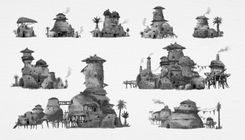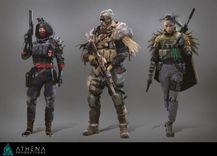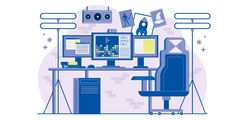Table of Contents
- What is Concept Art?
- The Purpose of Concept Art in Game Development
- Types & Stages of Concept Art
- How Concept Art Shapes the Final Game
- Tools & Techniques Used by Concept Artists
- Why is Concept Art so Underrated?
The Critical & Important role of Concept Art in Video Games
A behind-the-scenes look at how concept art shapes the visual identity, tone, and creative direction of video games from early sketches to final designs.
Long before players explore vast game worlds, concept artists have already shaped how those worlds look and feel.
Concept art forms the foundation of everything you can see in a game from environments and props to characters and beyond.
This blog explores the role of concept art, its stages, and its impact on game development and explains why it is an essential step in the process of designing video games!
What is Concept Art?
Concept art is the design phase that is used during the pre-production and production stages in films, video games, animation, and other creative projects.
Concept artists take an idea - whether written or verbal - and use digital art techniques to design how it will look visually. While concept art may seem purely creative, it is also practical work that helps collaboration across departments, such as 3D modellers.
By providing concept art of characters, environments, and props, concept art will help to establish the style, tone, and overall aesthetic of the game while working with real-world constraints such as budget, technology or time.
The Purpose of Concept Art in Game Development
Beyond creating beautiful images, concept art is a critical part of game development. It helps align artists and developers around a shared vision, while enabling teams to experiment with different ideas, whether that means exploring art styles or refining character designs, before committing to final versions.
Creating 2D designs first is far more cost-effective and time-efficient than jumping straight into 3D production, which can quickly drain both budget and schedule.
Concept artists also produce blue-sky paintings which are exploratory pieces designed to brainstorm freely, usually at the beginning of a project. These help establish the narrative tone and atmosphere of a game early on, providing a clear visual direction for the team.

The sketching process for some architecture, as shown by our Concept Artist Joris Halgand.
Types & Stages of Concept Art
Concept art covers a wide range of subjects, including:
- Character Concept Art – defining heroes, villains and NPCs.
- Environment Concept Art – visualizing landscapes, interiors and worlds.
- Prop & Weapon Design – detailing objects that enhance immersion.
- Key Art & Mood Boards – setting tone and style direction.
Regardless of subject, most concept art follows a similar workflow.
The process begins with a creative brief that outlines the idea, challenges, and references. For example, an artist might receive a brief for a medieval dock, which may need to be historically accurate or fit the project’s unique fantasy rules.
From there, the artist creates rough black-and-white sketches to explore ideas and possibilities. These concepts go through several rounds of feedback and revision before reaching a final design.
While this process can be summarized as sketch → refine → finalize, it actually involves significant collaboration and iteration between the artist, art directors, and other team members so concept artists have to be nimble and flexible in their approach.

How Concept Art Shapes the Final Game
From start to finish, concept art influences the look and feel of the final game.
For instance, if a vehicle needs to be designed, a concept artist begins with early sketches and develops them into detailed final illustrations which includes turnaround sheets and material references that 3D modelers and animators can use.
Having these visual guides prevents design miscommunication, ensuring consistency while saving both time and budget during production.
Ultimately, concept art ensures that players experience a cohesive, visually engaging game where every element from character designs to environments supports the narrative and gameplay.
Tools & Techniques Used by Concept Artists
Modern concept artists primarily use digital tools, which has evolved from traditional methods which reflects the modern, fast-paced nature of game production.
For 2D work such as sketching and painting, artists often use Adobe Photoshop or Procreate. For 3D work including blockouts, character models and environments, tools like Blender, ZBrush and Unreal Engine are common. The choice of software often depends on personal preference and workflow.
Traditional methods like pencil or ink sketches are still useful during early, quick-iteration stages, but most work transitions to digital fairly quickly.
Emerging technologies such as VR sculpting have introduced new ways for directors to visualize scenes in 3D space, though these techniques are not yet widely adopted.
Ultimately, the key to concept art is not the tool, but the result as artists must prioritize speed, flexibility, and iteration over perfectionism.
Why is Concept Art so Underrated?
Concept art often goes unseen due to its behind-the-scenes nature. Many pieces never make it into the final product as they may be too rough, unused, or created purely for exploration.
Players rarely see concept art unless it’s featured in an art book or special edition, yet they always feel its impact. From the mood of a cutscene to the design of the main character or the grandeur of a medieval landscape, concept artists play a crucial role in shaping the player’s experience.
Although some may view concept art as an added production cost, it actually saves time and money by clarifying creative direction early in development.
Without concept art, even the most brilliant game ideas would remain abstract and would struggle to find an art style that ties it all together. Concept art lays down the groundwork for the work that is to come during production.
Bring your game worlds to life with our team at Athena Productions, where we create expert concept art that combines storytelling, design, and player-focused creativity. Get in touch today!



